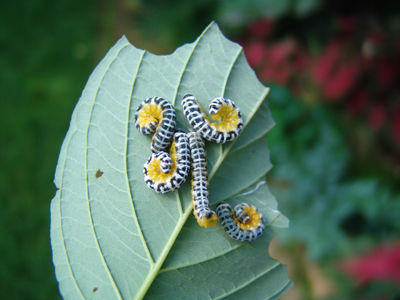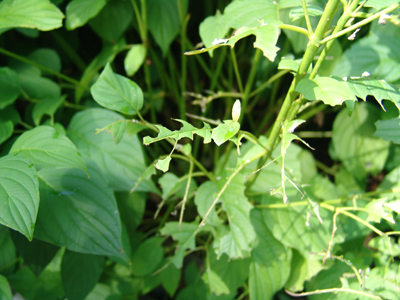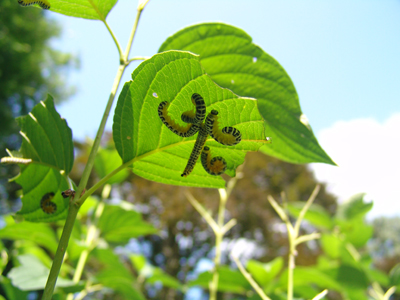Dogwood Sawfly

Dogwood sawfly, Macremphytus tarsatus, has been found on shrubby dogwood species on campus. While this pest looks like a caterpillar, it is actually the larval stage of a wasp-like Hymenoptera species.
Adult sawflies emerge in late spring and lay their eggs on the undersides of leaves. When the eggs hatch in mid-summer, the first stage larvae are tiny, yellow, and translucent. As they grow and molt, they become covered with a white waxy coating. They usually spend the daylight hours curled up and clinging to the underside of leaves. They can be quite gregarious, with a dozen or more congregating on one leaf. In large numbers, they can cause considerable defoliation and while unsightly, it usually will not harm the plant because it is late in the season. After the last molt, they usually stop feeding and seek a protected spot to overwinter. In early spring, they will pupate and later emerge as adults.

Leaf damage on shrubby dogwood. photo credit: W. Costello
The best control method is to handpick and drop them into a container of soapy water. You can also squash them under foot if you are so inclined (messy but effective.)
Occasionally, wasps or hornets will attack the larvae, which is fascinating to watch. They usually chew the sawfly in half and fly them back to their nest.

Dogwood sawfly on the underside of the leaf. photo credit: W. Costello
When the sawfly is detected early, insecticidal soap or horticultural oil is an effective control. In large plantings, chemical controls may be required. When the sawflies are larger, one of the contact or systemic insecticides registered for control may be needed.





Barbara Shaw
Posted at 09:48h, 24 AugustThanks for the blog. I now know what has been defoliating my dogwood.
Eve Thyrum
Posted at 11:38h, 24 AugustA beautiful little guy, but with too much of an appetite! So they were the ones responsible for making swiss cheese out of my Cornus stolonifera ‘Baileyi’. Thanks Bill!
Tom
Posted at 13:09h, 24 AugustIf you can stand the minor damage, these sawflys are a great source of food for early fall migrating birds. See Doug Tallamy’s book, “Bringing Nature Home–How Native Plants Sustain Wildlife in our Gardens” for more info…
Ann Bodling
Posted at 13:30h, 28 AugustGreat reference to Doug Tallamy’s book. Also see U of Minn website for more on the sawfly.
http://www.entomology.umn.edu/cues/Web/105DogwoodSawfly.pdf
The website lists the dogwood sawfly as a native pest and ranks the plant mortality potential as low. Why not leave them on the host plants, as Tom recommends, to feed the larger life that needs the nourishment to live and thrive? The cosmetic damage to the plant is just that, cosmetic. The nourishment to migrating warblers and thrushes can be lifesaving.
Drew Peogn
Posted at 14:40h, 28 AugustThanks Bill.
I was in ignorant bliss, thinking what I thought were just a few leaves with scalloped edges on my dogwoods to be deer browsing – still a possibility.
Once I started looking for them though they’re hard to miss, as is the damage they’ve caused. Mine are well past the cute little colorful stage in your photo, and are already coated with that white, waxy fluff. Still their less loathsome than the Pine Sawflies that feast on my Mugo Pine every few years.
Since they’re on Cornus sericea though, and most of what I really care about is their winter stem color I’m inclined to ignore them, and just do a good job cleaning up around them this fall. And if they’ll benefit migrating birds too then the few weeks of ratty leaves will be an acceptable loss.
If they show up again in worse numbers next spring I’ll deal with them then.
walter jordan
Posted at 12:05h, 31 AugustAnother pesky worm has killed my squash after eating near the ground!!
I wish i knew a way to remove from my garden!!
Thank you,
walter
Jack Cadwell
Posted at 18:38h, 13 SeptemberThank you for this post. I noticed the bugs because the birds were feasting. I feel better about having dogwoods if they feed the birds!
Jack Cadwell
heidi
Posted at 13:44h, 14 SeptemberThanks so much for this helpful entry. I just came rushing in after discovering my redtwig dogwood half defoliated and bunches of these on the undersides of leaves. Thanks to the “tubes” identidy discovered.
I agree with some of the above posters – think I’ll watch them, but leave them for the birds to enjoy. Next year, however, is a different story!!
Sandy
Posted at 09:56h, 03 AugustThese larvae are not harmless if your house is made of wood. They will corkscrew themselves into your siding and later a migrating woodpecker will dig in to get them. At first they leave only a little round hole, but if woodpeckers do come along, you will have not only destruction of the wood siding, log cabin, eaves, or whatever, but a very unsightly mess. I have found diatomaceous earth spread around the area, like my woodpile and wooden shed, where they want to bore, will slow them down.
Dee Ciabattoni
Posted at 13:54h, 23 AugustThis is great information. I don’t want to kill any critter unless it is going to cause serious problems for the area. (I am awaiting a return call from the university extension center to learn whether our area is affected.) If the birds need them, cosmetics are not important to me.
Thanks a lot.
Becky Patterson
Posted at 19:34h, 22 SeptemberThanks you. This is exactly what is munching away on my dogwoods.
Becky Robert
Posted at 08:15h, 23 SeptemberYour welcome, Becky. Good luck.
Sincerely,
Becky Robert
PR and Volunteer Programs Coordinator
Scott Arboretum
Erin S
Posted at 22:43h, 30 Juneare these toxic? i have american toads that would love to snack on them if not toxic. i dont want to feed them these and have the toads die…. my kids would never forgive me!!!!!
Lucy Birkett
Posted at 13:25h, 13 AugustPlease rethink use of this term “pest”. Most birds, and certainly the songbirds, NEED caterpillars to feed their young, and they need a lot of them– hundreds per day, or so i’ve been told. (Thanks to those who pointed to Doug Tallamy’s and other research) Using the word pest for a critter that plays an essential role in the food web, and in the health of our ecological systems, is like using the phrase “bad weather” for rain or snow. Sure, not every gardener may want to encourage these, but why start with how to kill them rather than the other way around, if you feel the need to get rid of them- very different. Also, because of the way they congregate to a few leaves, they can easily be removed and relocated to a wilder space nearby.
Mary Tipping
Posted at 09:35h, 31 OctoberLucy,
You are absolutely correct. While this caterpillar can consume foliage rather rapidly, it is some other organism’s “snack” (aka food source).
Mary Tipping
Scott Arboretum Curator & Plant Recorder
Thomas M Weaver
Posted at 10:47h, 02 Maycan i spray my dogwood bushes with something natural to protect them from this
caterpillar
Becky Robert
Posted at 08:16h, 04 MayThis link has good graphics showing what to look for on your plants from eggs to large larvae
https://hortnews.extension.iastate.edu/2009/8-12/sawfly.html
I hand pick them off.
Josh Coceano
Horticulturist
Scott Arboretum
Lars Rasmussen
Posted at 07:00h, 05 MayI usually also hand pick off large individuals. If there is a large population of early life cycle young, I sometimes spray with insecticidal soap. -Lars Rasmussen (Assistant Garden Supervisor, Plant Health)
Karen Voorhis
Posted at 22:17h, 25 AugustI’m with Tom at the top of the comments. Leave them be and help birds survive.
Jane H.- Indianapolis, IN
Posted at 10:44h, 30 AugustThank you for the information. I just discovered the worms on my Red Ostier Dogwood. I hope the birds find them soon!!
Sue F
Posted at 16:28h, 12 FebruaryI had over 35 Red Twig Dogwood Arctic Fire/Cornus stolonoifera ‘Farrow’ that year after year were devastated by sawfly caterpillars. The bushes were in a part shady area so the shrubs really were not happy at the onset. After 7 years of trying to keep up with the infestation, I gave up and removed the shrubs. It was too much for me to handle and would be quite expensive for yearly professional treatments. Truly, the shrubs looked horrible all year except winter. The birds did NOT feed on the caterpillars from what I could tell. I did replant a few shrubs. (I don’t have a sunny spot however). I will now use the diatomaceous earth, insecticidal soap and just picking them off and maybe the few shrubs will thrive. Here’s to hoping and thanks for the helpful information!